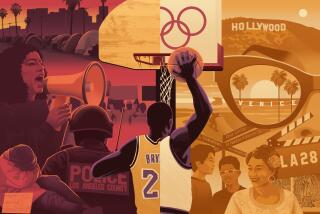Los Angeles: the parable
- Share via
What is the appropriate form of storytelling for Los Angeles? L.A., after all, is a city that defies traditional narrative, even as it requires us to impose our own structures on the chaos of the place. It’s no coincidence that some of the most iconic Southern California art has not been narrative but imagistic, as are the Light and Space creations of Robert Irwin and David Hockney, or aggressively elusive, like the barely controlled bombast of the 1970s punk scene.
What better way to evoke a city of unsettling distances than in flashes, snapshots: the glimmer of blue water on a canvas, three minutes of guitar fury in your car? Place one of Hockney’s swimming pool paintings alongside, say, a song like X’s “Johny Hit and Run Paulene,” and the juxtaposition tells you all you need to know about L.A., where illusion and reality bleed together in a strangely discontinuous collage. Even the best L.A. writing works like this, eschewing the larger story in favor of smaller, more interior visions, as if the city were accessible only in glimpses, if it’s accessible at all.
Norman M. Klein has made a career out of mining the impressionistic territory of memory from a cultural and an individual point of view. A professor at Cal Arts and the author of “The History of Forgetting: Los Angeles and the Erasure of Memory,” he sees L.A. as a landscape of amnesia, in which the past is either a burden or nostalgic, depending on how one puts it to use. This is especially true of the city center, where Klein has focused many of his investigations, deconstructing neighborhoods like Bunker Hill or Angelino Heights.
“By 1986,” he explains in “The History of Forgetting,” “I was running a series of lectures about the level of public neglect and bad faith in Los Angeles, entitled ‘Beneath the Myths.’ I started taking students on what I called ‘anti-tours.’ I would stop at locations where no buildings existed any longer, tell them what had been there once, a movie studio, a whorehouse, whatever. We would get out, look around, and agree that it was gone all right.”
For Klein, each absence operates as “what psychologists call an imago, an idealized face left over from childhood -- a photograph, the color of mother’s dress on the day she took ill (the photological trace).” They are “phantom limbs,” and by seeking to restore them, Klein invests his work with an air of social archeology in which excavation serves as a narrative device.
The notion of imagoes, of phantom limbs, informs “Bleeding Through: Layers of Los Angeles, 1920-1986,” a novella and accompanying DVD-ROM, that reconsiders both Los Angeles and the whole idea of narrative, presenting them as fixed and conditional at once. “Bleeding Through” can be read as a companion piece to “The History of Forgetting,” although such a treatment risks overlooking its authenticity. “Bleeding Through” is a study in digression, in simultaneous distractions, overwhelming in its information yet full of loss and silence.
Framed as an interactive mystery in which an elderly Angelino Heights resident named Molly may or may not have killed her second husband, Walt, it is more “a bildungsroman in which no one learns enough about anything,” a crime fiction in which “[t]he journey through the evidence is more exciting than the crime itself.” Part of Klein’s intention is to expose the artifice of storytelling by uncovering the background, what Don DeLillo calls the “underhistory” -- the invisible material that readers never see. At the same time, Klein is after something more expansive, a form in which resolution is less important than possibility.
“It is a daunting prospect,” he declares, “to give up all those newspaper clippings in order to make this story legible.... I have about a thousand photographs and newspaper articles, over two hundred relevant movies on file, and over twenty interviews ... and hundreds of pages of text. With all of these elegantly assembled in a DVD-ROM, I can follow Laurence Sterne’s advice (1760): to make an entertainment, a tristful paideia, a mocking of the truth.”
It’s only fitting that Klein should invoke Sterne here, for like Sterne’s “Tristram Shandy,” “Bleeding Through” is a tale that, in its multilayered interactivity, teaches us to read it as we go along. This is clear from the start of the novella, when we meet Molly walking down a hillside. An old woman with a beaded purse, she is vague, slightly distracted, or perhaps she displays what Klein refers to as “an absent-minded guile.” Either way, the implication is that there’s more to the moment than we’re seeing, which could also be said of Los Angeles.
Indeed, as the novella progresses, we realize that Molly is most important as a cipher, a symbol of the city’s life. Like Los Angeles, “[s]he has a genius for survival,” not to mention a history that parallels the region’s, from her arrival “in 1920 or 1919, after the war” to her dotage in a declining area three blocks above the Hollywood Freeway. That neighborhood is so isolated that “[s]ome city maps even erase some of its side streets.”
It was on these same streets, Klein tells us, “that more people were murdered in classic films than anywhere else on earth” -- a fact he uses to comment on the influence of Hollywood, as well as on several of L.A.’s other most enduring tropes. These include the aesthetics of noir, which he rejects as “built around racist and sexist egoism, mostly a white male tradition: what I call ‘white men caught in the wrong neighborhood,’ ” and the iconography of the boosters, with its heritage of deceit and greed. “I’ve decided,” Klein concludes, “that Walt is a drop in the bucket. The crime was the urban pathology itself, from 1920 to 1986. That would be my story, with Walt’s corpse as emblematic of traces we cannot decipher. And Molly as the great sieve of forgetting, the guardian of all that we really don’t want to know.”
The urban pathology to which Klein refers becomes apparent once we access “Bleeding Through’s” DVD-ROM. Here, Molly’s story quickly grows translucent: The closer we look, the more Klein blurs the line between what’s real and invented, between the character and the city, fiction and truth. To help us navigate this shifting landscape, Klein and his digital collaborators divide the DVD into three tiers: “The Phantom of a Novel” (an exploration of Molly’s seven most essential memories, including a 1923 encounter with Gloria Swanson and the Flood of 1938), “The Writer’s Backstory” and “Excavation: Digging Behind the Story and Its Locale.”
Each tier takes us deeper into the amorphous territory of collective imagination, in which the juxtapositions we discover are often unanticipated, depending on how we interact with the work. A clip from Lee Katzin’s 1957 film “The Man Who Liked to Look at Women” takes on a whole new meaning if you watch it while listening to Klein -- who appears throughout the DVD to offer comments -- discuss Molly’s first husband, Jack; suddenly Jack is the movie’s protagonist, a lonely middle-aged man wandering the streets he used to know. The same is true of the photos of old L.A. on the DVD, many of which update themselves with a single mouse click, slowly bleeding from past to present, ancient buildings eclipsed by the structures that now stand in their place. (Another click reverses the process, as if to bring the ghosts of the city back to life.)
If there’s an underlying principle at work here, it is aporia, a Greek idea that Klein defines as a kind of willful dissociation, a way of looking for, and finding, what you least expect. “To achieve aporia,” he points out, “the ancient Greeks learned how to lose track of the road itself, to be baffled, trained themselves to give the wrong answer to the wrong question.” What he’s getting at is a narrative strategy that reflects Los Angeles, the idea we often have of the city as open-ended, inconclusive -- a series of beginnings rather than any definitive end.
“I believe that the unreliable narrator is an absence,” Klein notes, “like a chiaroscuro. The absence is a camera, an aperture.... Beyond the frame of this aperture lies something more interesting than the answer to a crime.... Absence is a lingering distress that is deeply pleasurable; and truer to the way we actually live than a corpse dropped on the lawn. It is the trace left by a crime, the erasure and forgetting of a crime.”
This idea, of course, is in the very nature of interactive media, which makes the DVD (perhaps) an ideal device for coming to grips with L.A. No matter where we click, “Bleeding Through” takes us someplace unanticipated; disordering our senses by offering a small museum’s worth of pictures, newspaper clippings, movie scenes -- all the fragmentary detritus that makes up the city’s life.
At the same time, Klein and his colleagues have developed an interface that works like memory, loading different items from the database each time we use the DVD, so that we never see the same sequence of information twice. Clips recur or disappear; characters linger and then fade away, until we forget they were ever there. This marks another way in which “Bleeding Through” asks us to reconsider our own preconceptions, our expectations, the very process of how we “read.” To enter this work is to engage with its creators in a conversation about what the city means. That there is no consistent through line for us to follow highlights the idea that L.A. resists definition: It is not merely a landscape of erasure but one of the imagination as well.
The paradox is that such a process may confound us even as it excites us, that it can be both limiting and profound. Concept aside, after all, it’s difficult to scan “Bleeding Through” for something specific -- footage of the Red Cars, or Chavez Ravine before the Dodgers -- because there’s a good chance you might not find it, might end up getting sidetracked into other memories, other aspects of the city’s life. This frustration is only heightened by the fact that, on their own, these clips are an invaluable repository of L.A. history, made up primarily of images we haven’t seen. If there’s a soft spot to “Bleeding Through’s” archive, it has to do with the Hollywood productions (including “Chinatown,” “D.O.A.,” “Falling Down” and “Kiss Me Deadly”) Klein addresses, all of which were shot, in part, in Molly’s neighborhood. Given the cost of rights, these movies are represented by re-creations, with a video camera duplicating angles as a voice-over describes the action of the scene. That’s an understandable solution, but compared with the real footage, the staged moments fall flat, operating as neither experience nor memory.
In the end, however, all this seems aesthetically consistent, for L.A. is, as Klein suggests, a city that cannot help but forget itself. It’s not just Molly, who, approaching 90, is no longer able to “distinguish day from night”; it is the very culture, L.A. as both physical and psychic environment. From noir to the boosters, from Bunker Hill to Hollywood, this is a zone of erasure, of unearthing, a territory defined by myths and overlays. It is less a narrative than a mosaic -- or better yet, a tapestry. What Klein has done is extract the various threads of that interweaving, allowing us to see them one by one. In the process, he has created a work that is both fixed and fluid, accessible and distant, much like Los Angeles.
More to Read
The biggest entertainment stories
Get our big stories about Hollywood, film, television, music, arts, culture and more right in your inbox as soon as they publish.
You may occasionally receive promotional content from the Los Angeles Times.











